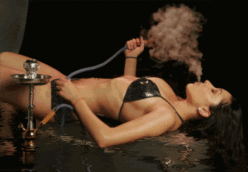
In this painting two men are making coconuts into hookah-bases. The origin of the hookah, narghile, sheesha, hubble-bubble or water-pipe device is uncertain; it is believed to have started in India, but with coconut shells as containers. Aromatic and medicinal herbs were smoked before the arrival of tobacco in the Indian sub-continent 500 years ago. The sophisticated version, widely used in Africa and Asia, developed with the spread of Turkish coffee-houses to smoke a compound of tobacco, spices, molasses and fruit. Charcoal embers heat the substances, smoke is inhaled through a mouthpiece attached to a hose after passing through a pipe and container filled with water, which refines and cools it. The containers, once of coconut shell, are now elaborate and of glass or metal. The term ‘narghile’ is from Persian while ‘hookah’ is from Arabic denoting a rounded casket. Hookahs were a common feature of 19th century European dining in India with hookahburdars, or hookah-bearers, tending the hookahs. It was a breach of etiquette to step over another’s hookah-carpet or hookah-snake.
